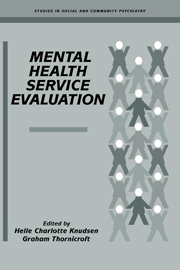Book contents
- Frontmatter
- Contents
- List of contributors
- Foreword
- Preface
- Part I INTRODUCTION
- Part II COMPREHENSIVE SERVICE EVALUATION PROJECTS
- Part III METHODS: MEASUREMENT, STRATEGIES AND NEW APPROACHES
- Part IV SYSTEM-LEVEL RESEARCH
- 12 Sectorised services outcome research
- 13 Dynamic analysis of patterns of care
- 14 Social indicators of outcome at the system level
- 15 Psychiatric admission rates: the relationship with health and social factors and the effects of confounding variables
- Part V PROGRAMME-LEVEL RESEARCH
- Part VI HEALTH ECONOMICS IN MENTAL HEALTH
- Index
15 - Psychiatric admission rates: the relationship with health and social factors and the effects of confounding variables
from Part IV - SYSTEM-LEVEL RESEARCH
Published online by Cambridge University Press: 05 August 2016
- Frontmatter
- Contents
- List of contributors
- Foreword
- Preface
- Part I INTRODUCTION
- Part II COMPREHENSIVE SERVICE EVALUATION PROJECTS
- Part III METHODS: MEASUREMENT, STRATEGIES AND NEW APPROACHES
- Part IV SYSTEM-LEVEL RESEARCH
- 12 Sectorised services outcome research
- 13 Dynamic analysis of patterns of care
- 14 Social indicators of outcome at the system level
- 15 Psychiatric admission rates: the relationship with health and social factors and the effects of confounding variables
- Part V PROGRAMME-LEVEL RESEARCH
- Part VI HEALTH ECONOMICS IN MENTAL HEALTH
- Index
Summary
Background
As long ago as 1939 Faris and Dunham drew attention to the higher rate of psychiatric admissions of people living in inner city areas. Hare in 1956 confirmed the high admission rate from schizophrenia in electoral wards with a high proportion of people living alone. There are higher proportions of people living alone in inner city areas but these studies do not prove that the stress of inner city life or the problems of social isolation are the cause of the associated higher psychiatric admission rates. Since these early studies other social factors, such as higher proportions of ethnic minority groups, and of working class, poor and unemployed people have similarly been shown to correlate with higher usage of psychiatric inpatient services (Thornicroft, 1991). It is possible to suggest a number of hypotheses: that social isolation, poverty and social disruption cause the psychiatric illnesses, or that the greater availability of services is associated with their higher usage, or that people with these social problems tend to drift into inner city areas, and so on. The aim of this chapter is to examine the relationship between psychiatric admission rates on the one hand and health, social and demographic factors on the other and to attempt to disentangle the possible influence of confounding variables.
Confounding
As an example of the influence of a confounding variable, suppose that the incidence of a disease is elevated in a population living near a factory which employs a high proportion of working class people and a research study is being designed to investigate whether proximity to the factory is associated with the increased incidence of the disease near the factory (Jolley et al., 1993). The population living around the factory are not a random sample of the general population but are more likely than average to be of working class status. Members of the working classes are known to have a higher than average incidence of many diseases (Department of Health and Social Security, 1980). Social class factors are therefore likely to confound the relationship between disease incidence in the population and proximity to the factory.
- Type
- Chapter
- Information
- Mental Health Service Evaluation , pp. 245 - 256Publisher: Cambridge University PressPrint publication year: 1996
- 2
- Cited by



